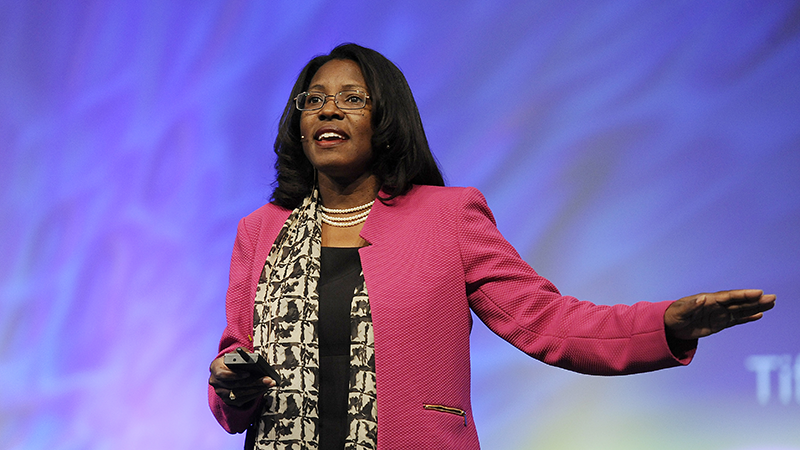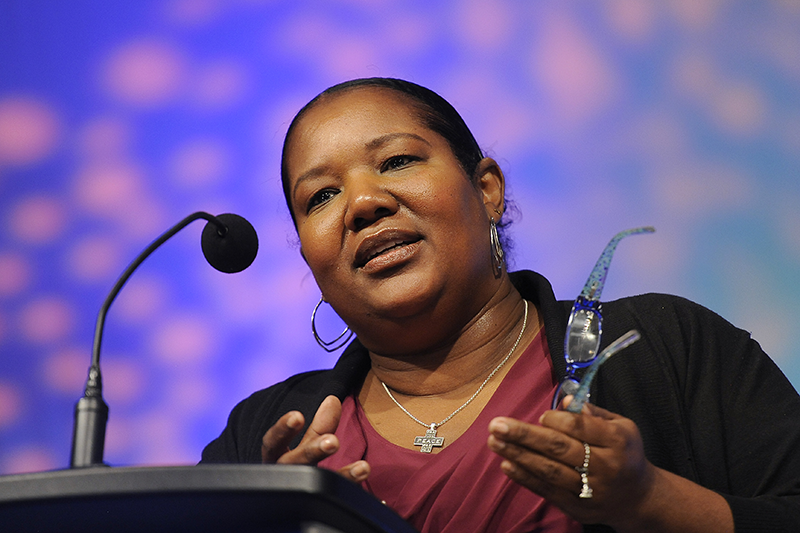
Topeka School District Superintendent Tiffany Anderson speaks at the 2016 Colorado Health Symposium. Photos by Chris Schneider for the Colorado Health Foundation
Topeka School District Superintendent Tiffany Anderson speaks at the 2016 Colorado Health Symposium. Photos by Chris Schneider for the Colorado Health Foundation
Health doesn’t happen in the doctor’s office. That’s the consensus of decades of research into what really impacts how long we live and how well. Social, economic and environmental conditions tend to outweigh medical care; how we prevent disease is often much more important than how we treat it.
Knowing that is one thing. Taking action on it is another.
What do we make of the fact that the U.S. spends disproportionately on health care compared with other developed countries, and underspends on social services? What do we do with hospital systems that are set up to profit from people’s sickness, and not their health? Knowing that social inequities in our country have created gaping disparities in life expectancy, how can we fix structural issues like racism, income inequality, exploitation?
These were the main questions on the table at this year’s Colorado Health Symposium, an annual gathering of state policymakers, health care providers and researchers hosted by the Colorado Health Foundation.
There were solutions on offer, too. Some of the most compelling ones were, ultimately, human acts of empathy and creative problem-solving.

Stuart M. Butler
Stuart M. Butler, PhD, a researcher with the Brookings Institution, suggested that schools, public housing and hospitals could become “hubs” for health—places where all kinds of services are brought together.
If that sounds too abstract—or expensive—consider the example set by Tiffany Anderson, EdD.
Before Anderson took her new job as superintendent of the Topeka School District, she led a dramatic turnaround at the high-poverty school district of Jennings, Missouri, outside of St. Louis.
She did it, she explained, by listening to her students and their parents. They didn’t have a place to clean their clothes; she put washers and dryers in the schools. Some of the kids were homeless; the district opened a shelter. Students were angry about police brutality; Anderson led them in a march to the city police department, helping them win commitments for more community policing, minority hiring and body cameras.
An important part of her strategy, said Anderson, was to redirect existing resources to the areas that mattered most for the children and families she served—areas that, at first glance, aren’t at all about maintaining a school district. These efforts to meet students’ basic needs outside of the classrooms paid off inside them; academic achievement soared almost immediately.
Don’t ever let anybody tell you it takes four years to turn around a school, Anderson told the audience at the symposium. How many high school students could have graduated in that time? How many more families could fall into poverty? “Nobody has that kind of time,” she said.
Not a school superintendent? You’re not off the hook. There are other kinds of hubs.

Gloria Wilder
Gloria Wilder, MD, MPH, gave two examples. One was Core Health and Wellness Center, which she founded after realizing that there was no way for her, working in her previous capacity as a pediatrician in a hospital, to bill for keeping someone healthy. The center offers not only medical care but also fitness classes, massage, mindfulness classes and a warm and inviting space to families in Anacostia, a deeply underserved, mostly black neighborhood in Washington, D.C.
Wilder’s other example was from the receiving end of an act of love. She recalled, as a child growing up poor, going to buy a quarter pound of bologna and a bag of bread from the corner store. She had only 99 cents in change scrounged from sidewalks—not enough to pay for it. As she marched to the counter, a group of children swarmed in behind her, leaving her in fear that she’d be unmasked.
“In my head I’m thinking, ‘now they all gonna know I’m poor,’” she said.
But instead of turning her away, the man behind the counter, Duke, presented Wilder with a pound of bologna, a pound of cheese, a bag of bread, chips and ice cream. And gave her a quarter in change.
“That quarter told that little girl that she was worth something, and that her family was to be respected, and that the journey we were going on wasn’t our fault—it just was,” Wilder said through tears. “That quarter got me to be a pediatrician… and brings me to you today, to just say, as you think about all the craziness you’re about to see on TV for the next 100 days, as you think about these shootings and all this nonsense, just remember that you always have an opportunity to be a Duke in the life of a child here in the United States or anywhere in the world. Doing the right thing is your return on investment.”
Return on investment is a business term that’s found its way to health care spheres as providers and policymakers have struggled to defend spending resources on people by pointing to potential rewards (typically financial ones) down the line.
Scaling up is another such term. Duke’s kindness helped one little girl, but how do you multiply that?
The history of health and human disease offers one ancient yet still effective model for scaling up that doesn’t require an app or a profit motive: Contagion.
“Moving toward justice requires empathy,” said Wilder.
And empathy is contagious.